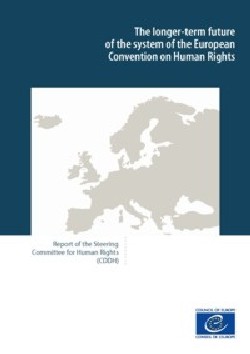Longer-term future of the ECHR System

Four overarching areas were considered as crucial for the longer-term effectiveness and viability of the Convention System:
- National implementation of the Convention;
- The authority of the Court;
- The execution of judgments and its supervision;
- The place of the Convention in the European and International legal order.
The challenges inherent in each of these fields were identified, along with the responses to be given by all actors in the Convention System.
At their 1252nd meeting, the Ministers’ Deputies welcomed the report of the CDDH on the longer-term future of the System of the European Convention on Human Rights, took note of the Court’s comments on the report, and agreed on its follow-up.
Concerning the work entrusted to the CDDH, the Deputies agreed on the following:
“deemed it essential that the judges of the Court enjoy the highest authority in national and international law and to this end instructed the CDDH to examine, while securing the participation of the Court and all other relevant actors concerned, the whole selection and election process, including all factors that might discourage possible candidates from applying, in the light of conclusion § 203 i) and the relevant paragraphs of the report;”
“instructed the CDDH to carry out a detailed analysis of all questions relating to the place of the Convention in the European and international legal order and on the medium-term and longer-term prospects, in the light of the relevant paragraphs of the report (conclusion § 203 iii).”
Preparatory work relating to the first analysis were entrusted to the Drafting Group I on the follow-up to the CDDH report on the longer-term future of the System of the Convention (DH-SYSC-I).
Preparatory work relating to the second analysis were entrusted to the Drafting Group II on the follow-up to the CDDH report on the longer-term future of the System of the Convention (DH-SYSC-II).
Background documentation
Selection and election of judges of the European Court of Human Rights
DH-SYSC-I meetings
4TH meeting, 18-20 OCTOBER 2017
3RD meeting, 27 FEBRUARY-1 MARCH 2017
2ND meeting, 19-21 OCTOBER 2016
1ST meeting, 29 JUNE-1 JULY 2016
Background documentation
- [Draft] Outline of the future report of the CDDH on the place of the Convention in the European and international legal order
- Context of the work of the DH-SYSC-II on the future report of the CDDH
- Decisions adopted at the 1252nd meeting of the Ministers Deputies on the CDDH Report on the longer-term future of the system of the European Convention on Human Rights (30 March 2016)
DH-SYSC-II meetings
7th meeting, 18-20 SEPTEMBER 2019
- Meeting Report
- Addendum to the Meeting Report: Preliminary draft CDDH Report on the place of the European Convention on Human Rights in the European and international legal order, as adopted at the 7th DH-SYSC-II meeting
- Draft agenda
6TH meeting, 22-24 MAY 2019
5TH meeting, 5-8 February 2019
4TH meeting, 25-28 SEPTEMBER 2018
3rd meeting, 3-5 April 2018
2nd meeting, 20-22 SEPTEMBER 2017
1st meeting, 30-31 MARCH 2017

Thorbjørn Jagland, Secretary General of the Council of Europe
Useful links:
Secretary General
Directorate General of Human Rights and Rule of Law
Committee of Ministers
Parliamentary Assembly
Access to Official Documents (TROMSØ CONVENTION)
Department for the execution of the Court's Judgments
European Court of Human Rights
Council of Europe Commissioner for Human Rights
HELP – European Programme for Human Rights Education for Legal Professionals
Online Plateform Human Rights and Business


